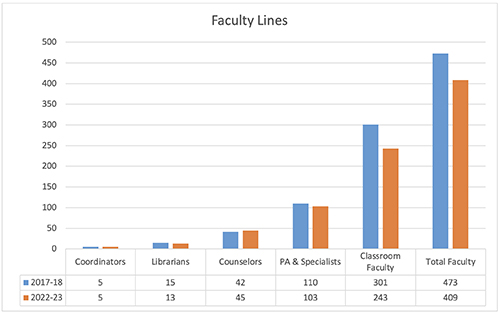Kevin McCoy
The FA is 53 years old. Founded on March 10, 1970, the college looked very different than it does today. As the chart below indicates, in 1969-70, there were 9,667 students at the college, and among the full-time ranks 175 classroom faculty, 8 counselors, 7 librarians and 22 professional assistants (PAs) and specialists. Sounds so quaint now. But that was half a century ago, and the numbers today tell a very different story. Every couple of years the FA publishes an analysis of the number of full-time faculty lines at the college. I was going through The WORD archive and came across this article published in the February 2018 issue. While we have been tracking the loss of faculty lines, it was still jarring to see how many lines we have lost in the last five years. In the 2017-18 academic year, we had a total of 478 full-time faculty lines. This year we have 409 full-time faculty. This includes losing almost 20% of our classroom faculty lines in the past five years. Due to reorganization, we be losing another five FA members to the Guild after elections are held this semester. There are contributing factors on why we lost so many faculty lines: declining enrollment, numerous retirements, the pandemic, etc. However, if you look at the number of full-time lines overall at the college, the number of administrative lines has increased over the years. In the June 2020 issue of The WORD, we did a historical analysis of the college staffing. In addition to losing faculty lines, the number of full-time AME lines have decreased as well. Our analysis continues, and we will be updating this article in our June 2023 issue. Why is this important? I know that I am preaching to the choir, but numerous studies have shown that students’ access to full-time faculty is one of the biggest determinants on retention. While we have outstanding adjuncts, they are not paid to hold office hours, do academic advising, participate in curriculum development or advise clubs. Adjuncts are less likely to be aware of the academic and student services that are available. We cannot have a serious discussion about retention unless we acknowledge the importance of having full-time faculty available to students who are struggling to make it through the semester.
|
